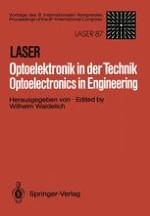1987 | OriginalPaper | Buchkapitel
Static Induction Phototransistor (SIPI) and Ultrasensitive Lightsensor (Hybrid ICs) Using a Sipt
verfasst von : Tetsuya Nakajima, Hiroshi Oshitari, Jun-ichi Nishizawa
Erschienen in: Laser/Optoelektronik in der Technik / Laser/Optoelectronics in Engineering
Verlag: Springer Berlin Heidelberg
Enthalten in: Professional Book Archive
Aktivieren Sie unsere intelligente Suche, um passende Fachinhalte oder Patente zu finden.
Wählen Sie Textabschnitte aus um mit Künstlicher Intelligenz passenden Patente zu finden. powered by
Markieren Sie Textabschnitte, um KI-gestützt weitere passende Inhalte zu finden. powered by
SIPT is a photosensor developed by Professor Nishizawa (Tohoku University, Japan) in 1977. Based on the SIPT we have developed an ultrasensitive light sensor as a Hybrid IC.Very low noise generation, high sensitivity, wide dynamic range, etc. as being the characteristical features of the SIPT make this Hybrid IC an ideal component. Selecting the small temperature coefficient as operating point and using differential amplifiers at the output enables a minimized drift against ambient temperature. Main applications are faint light irradation detection and measurement, long distance data/information communication by near-infrared, various kinds of control systems, etc.Main features of this device are: Spectral wavelength; approx. 400nm–1000nmAmplification; 1 × 107 V/WCutoff Frequency; 100KHzOutput Noise voltage; $$ \mu V/\sqrt {Hz} $$There are 2 package types of the Hybrid IC, one is the “head-on Type” (leads and photo sensitive surface oppose) and the other is “side-on type” (leads and photo sensitive surface meet at right angle).
